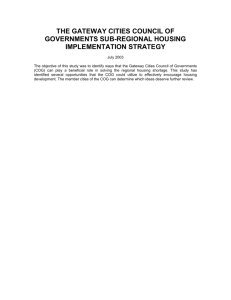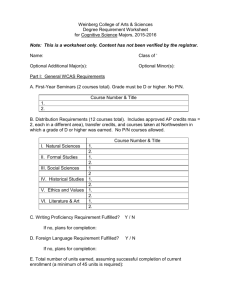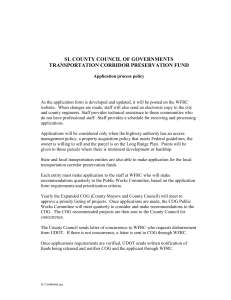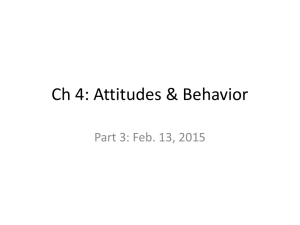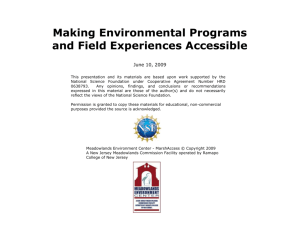Visit our website for other free publication downloads
advertisement
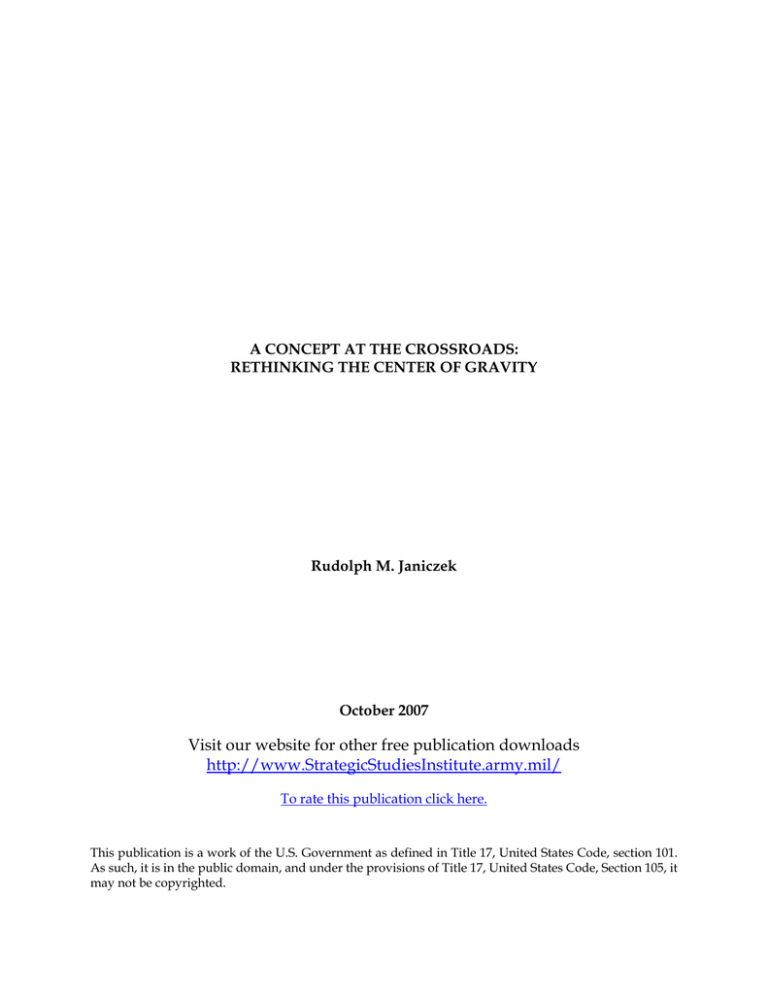
a CONCEPT AT THE CROSSROADS: RETHINKING THE CENTER OF GRAVITY Rudolph M. Janiczek October 2007 Visit our website for other free publication downloads http://www.StrategicStudiesInstitute.army.mil/ To rate this publication click here. This publication is a work of the U.S. Government as defined in Title 17, United States Code, section 101. As such, it is in the public domain, and under the provisions of Title 17, United States Code, Section 105, it may not be copyrighted. ***** The views expressed in this report are those of the author and do not necessarily reflect the official policy or position of the Department of the Army, the Department of Defense, or the U.S. Government. This report is cleared for public release; distribution is unlimited. ***** Comments pertaining to this report are invited and should be forwarded to: Director, Strategic Studies Institute, U.S. Army War College, 122 Forbes Ave, Carlisle, PA 17013-5244. ***** All Strategic Studies Institute (SSI) publications are available on the SSI Homepage for electronic dissemination. Hard copies of this report also may be ordered from our Homepage. SSI's Homepage address is: www.StrategicStudiesInstitute.army.mil. ***** The Strategic Studies Institute publishes a monthly e-mail newsletter to update the national security community on the research of our analysts, recent and forthcoming publications, and upcoming conferences sponsored by the Institute. Each newsletter also provides a strategic commentary by one of our research analysts. If you are interested in receiving this newsletter, please subscribe on our homepage at www. Strategic Studies Institute.army.mil/newsletter/newsletter.cfm. ISBN 1-58487-322-1 ii PREFACE The U.S. Army War College provides an excellent environment for selected military officers and government civilians to reflect and use their career experience to explore a wide range of strategic issues. To assure that the research developed by Army War College students is available to Army and Department of Defense leaders, the Strategic Studies Institute publishes selected papers in its “Carlisle Papers in Security Strategy” Series. ANTULIO J. ECHEVARRIA II Director of Research Strategic Studies Institute iii ABOUT THE AUTHOR RUDOLPH M. JANICZEK, a Marine Corps lieutenant colonel, is assigned to the J-3, U.S. Special Operations Command. He has commanded at the battery and battalion levels and served in a number of staff assignments involving operational planning at the Marine Expeditionary Force and Marine Component levels. Lieutenant Colonel Janiczek is a 2007 graduate of the U.S. Army War College where he participated in the Advanced Strategic Arts Program. iv ABSTRACT Since the 1980s, the U.S. military has placed great emphasis on the theories and concepts of Clausewitz. Concomitantly, a tremendous emphasis has been placed in doctrine on the center of gravity (COG) as a central element of campaign planning. The doctrinal definitions of the COG are still imperfect, but the concept arguably serves as an effective tool for focusing military effort to win decisively in major operations or campaigns. Although the American military performs brilliantly in decisive operations, the difficulties it has faced in Iraq and Afghanistan suggest that a doctrinal renaissance is in order. This paper examines the potential for employing the COG concept in areas beyond the realm of decisive operations. After examining the concept’s evolution, present doctrinal manifestations, and some previous proposals for future employment, the author opines that the COG’s role in American military thinking is flawed and must be reconsidered entirely. To that end, three options are offered for evolving the COG, with a specific recommendation that it would be most effective if removed from doctrine and considered as an abstract concept, rather than a practical one. v a CONCEPT AT THE CROSSROADS: RETHINKING THE CENTER OF GRAVITY Introduction. Since the 1980s, the military education system has placed great emphasis on the study of the operational art and the theories and concepts of Clausewitz. Concomitantly, a tremendous emphasis has been placed in doctrine on the center of gravity (COG) as a central element of campaign planning. After almost a quarter of a century, there is still lively debate over the precise meaning of the COG: the services and joint community continue to parse words over a precise doctrinal definition; staff colleges devote countless hours to its study; and scholars and pundits debate its origin and optimal application with numbing frequency. All of these activities speak to the concept’s pervasiveness. It is solidly ensconced in military thinking and parlance, and this is understandable. The COG serves as a giant lens for focusing military effort to achieve decisive results in major operations. The effective application of military power to such ends involves taking into account a complex array of issues, all of which are unique to any given circumstance. When taken with the requirement for thorough but rapid planning and the proclivity for military professionals to argue over priorities, it is easy to see why such a concept fits so well into military culture. Further, given the U.S. military’s prowess at winning tactical and operational engagements decisively over the past 15 years, few in the military would argue that the COG concept has not served it well. As good as the military is at winning decisive battles, it now finds itself paying the penalty for incomplete thinking. The highly effective decisive operations that made fugitives of the Taliban and removed Saddam Hussein from power have each evolved into a prolonged struggle to provide stability to transforming societies and legitimacy to new broad-based governments. Decisive operations, the military is rediscovering, do not necessarily win wars. The current strategic landscape and the nature of what has come to be known as The Long War suggests that the time is ripe for a renaissance in military thinking. A more holistic approach to war, extending well beyond the realm of major decisive operations, is currently mandated, which in turn calls for a corresponding recalibration of the military mindset. Such change, among other things, necessitates adjustments to doctrine, thus bringing a discussion of the COG’s relevance to the forefront. Can the COG concept be useful in ways lying beyond the context of decisive operations, should it be applied in that broader context, and, if so, how? These are the central questions of this paper. After briefly examining the COG concept‘s evolution, its present doctrinal form, and some suggestions for its future, this paper proposes that the COG’s role in American military thinking must be radically reconsidered. In this regard, the paper briefly discusses three options for evolving the COG concept from its present form. It then narrows discussion to the most promising one of these options, specifically concluding that the COG can realize its fullest potential in facilitating the successful prosecution of war if it is regarded as a broad, abstract principle for focusing the total national effort in theater rather than simply a practical formula for selecting battlefield targets and objectives. 1 Interpretation of an Enduring Metaphor. There is a paradoxical quality to the COG in American military culture. Its existence is an integral, taken-for-granted part of the war planning process; yet, an enormous amount of intellectual energy has been expended in attempts to precisely define the concept. The genesis of the COG in U.S. military doctrine is generally attributed to Clausewitz’s famous and oft-cited passage from On War: One must keep the dominant characteristics of both belligerents in mind. Out of these a certain center of gravity develops, the hub of all power and movement, on which everything depends. That is the point against which all our energies should be directed.1 Rather than simplifying matters, however, the efforts to translate Clausewitz’s theory into a concrete doctrinal concept has arguably complicated matters, resulting in a complex of ideas that are remote from what seems to be an effective and simple Clausewitzian metaphor drawn from the field of physics. Put another way, the military’s efforts to put the concept to practical use may have actually limited its potential. Thus, a brief examination of how the concept evolved to its present form—and the ongoing debates about its flaws—must precede any discussion of how best to apply it in the future to secure greater advantage. Some of the earliest writings about the COG capture the impetus for embedding the concept in official doctrine. Against the backdrop of the waning days of the Cold War and the threatening behemoth formations of the Warsaw Pact, the U.S. military focused on finding a doctrine that ensured success for “an operational commander who expects to fight outnumbered and win.”2 Highly problematic at the time was the lack of cohesive joint doctrine. The services put their own parochial spin on the concept as they attempted to incorporate it into their separate doctrines, often in isolation from the interpretations and applications by sister services. Some of the notorious inconsistencies that resulted remain today. Joint Publication 1-02 establishes the current definition of a COG as “the source of power that provides moral or physical strength, freedom of action, or will to act.”3 This definition is closely paralleled in Army doctrine, though the Army’s version is more closely associated with an enemy’s forces. The Army definition adds that, in theory, “destruction or neutralization of the enemy COG is the most direct path to victory.”4 The Air Force also accepts the joint definition, but nonetheless offers a much more detailed, service-specific version: In Air Force terms, a COG is a primary source of moral (i.e., political leadership, social dynamics, cultural values, or religion) or physical (i.e., military, industrial, or economic) strength from which a nation, alliance, or military force in a given strategic, operational, or tactical context derives its freedom of action, physical strength, or will to fight.5 The Marine Corps, like the Air Force, is quick to acknowledge the joint definition, but also has a service-specific point of view to offer. “In short,” Marine doctrine states, “centers of gravity are any important sources of strength.”6 Interestingly, Marine Corps doctrine also offers a strong caveat: “We want to attack the source of enemy strength, but 2 we do not want to attack directly into that strength. We obviously stand a better chance of success by concentrating our strength against some relative enemy weakness.”7 Thus, the Marine Corps offers the complementary concept of a critical vulnerability (CV), or “an aiming point for the application of friendly strengths against threat weakness.”8 The Navy also acknowledges the existence of CVs, yet views the manifestation of the COG slightly differently. Naval Doctrine Publication-1 proclaims that “the COG is something the enemy must have to continue military operations—a source of his strength, but not necessarily strong or a strength in itself.” In contrast to the doctrine of the other services, the Navy adds that there “can only be one center of gravity.”9 While incongruities abound as to how the COG manifests itself, all of the services seem to agree that the COG is a source of strength. The confusion has been minimized to some extent in recent years through thought and dialogue. One effort stands out. No doubt heeding the call to transform the COG from “an alluring Clausewitzian buzzword to a useful element in U.S. strategic planning,”10 Dr. Joseph Strange of the U.S. Marine Corps War College faculty offered an analytical method to operationalize the concept. Accepting the COG as a physical or moral source of strength, Strange proposed a methodology for distinguishing between a COG and the critical factors associated with it. Specifically, his methodology offers operational planners a means to examine a COG (i.e., source of enemy strength), identify the critical capabilities (CC) it possesses, and ascertain critical requirements (CR) associated with those capabilities. Operational planners can examine CCs and CRs for deficiencies or susceptibility to attack, thereby deriving CVs.11 Dr. Strange’s analytical model, offered almost a decade ago, has been generally accepted in the joint community, forming the foundation for COG analysis in current joint doctrine.12 True, the joint definition and process for analysis are not yet universal; however, their existence indicates that a substantial consensus on the COG as a source of strength with identifiable factors has emerged. The ascendancy of the concept as a tool for focusing the application of force has brought with it a general belief in its implementation as a key to victory. The gradual success in melding the services’ ideas in a broadly accepted COG paradigm is laudable, if only because it represents a triumph over parochialism and bureaucracy. Yet, some might justifiably suggest that the American military has taken the COG concept—ostensibly born of Clausewitz’s metaphor in On War—too literally, or has interpreted it incorrectly. In other words, possibly Clausewitz’s intended meaning has been obscured, and serious deficiencies have appeared in evolving U.S. doctrine as a result. A number of academics and pundits have cautioned military professionals about attempting to interpret Clausewitz too literally. In the online version of an essay that has won over many staff college students to the work of Clausewitz, Dr. Christopher Bassford of the National War College faculty points out the problematic and somewhat inconsistent manifestations of the COG term in On War itself. Acknowledging that Clausewitz periodically applied the term to specific instances of overridingly critical areas of vulnerability, Bassford asserts that Clausewitz also “often used it in very general terms to mean something like ‘the main thing’ or ‘the key point at issue’.”13 The implication is that Clausewitz was not terribly concerned with creating an enduring concept to 3 facilitate decisive operations, but rather with advising the military professional simply to “focus on key considerations, rather than frittering his energy away on peripheral concerns.”14 When considered in this broader context, the COG becomes much more situational and, arguably, elusive. “To seek for an all-purpose strategic prescription in Clausewitz’s discussion of the center of gravity,” Bassford cautions, “will . . . lead to the usual frustration.”15 The term “the most relevant concern” might better capture the meaning of a Clausewitzian COG under Bassford’s line of reasoning. If such reasoning is valid, the American doctrinal definitions of the COG as a source of strength may not be in consonance with Clausewitz’s original metaphor. The source of an adversary’s strength, in other words, may not always equate to what in the total context of a particular war is most relevant. Another authority overtly critical of the doctrinal COG is Dr. Antulio Echevarria, a widely respected historian and Clausewitzian scholar from the U.S. Army War College’s Strategic Studies Institute. Echevarria contends that in its attempts to understand and apply Clausewitz’s idea, the American military actually drifted away from it. Specifically, Echevarria suggests that the U.S. military’s classification of the COG as an adversary’s strength or capability is flawed. This misinterpretation, he tells us, may be traced to imperfections in the Michael Howard-Peter Paret translation of On War (Princeton: Princeton University Press, 1984), the edition used as a text at the U.S. Army War College and read widely by today’s military professionals. Offering his own translation and explication, Echevarria poses the proposition that Clausewitz’s physical science term center of gravity as an analogue for a military concept was a very close one. In such a context, the COG concept speaks to the interdependence or unity of the various parts of an adversary. The COG, so construed, “exerts a certain centripetal force that tends to hold an entire system or structure together; thus, a blow at the COG would throw an enemy off balance or even cause the entire system (or structure) to collapse.”16 Therefore, under Echevarria’s interpretation, the COG is an operational construct entertained by Clausewitz exclusively for action against a cohesive adversary in a war to defeat that adversary completely. Echevarria makes a compelling argument that an attempt to apply Clausewitz’s COG concept within the context of limited wars or decentralized opponents would be futile.17 Taken together with nonconformities in service definitions and the ongoing debate in the joint community, the reservations and attempted clarifications among these scholars demonstrate a fundamental point: despite the zeal the U.S. military has for making the COG a central element of operational planning, as a practical matter it remains decidedly problematic. Much of the controversy continues to stem from differing opinions evoked by Clausewitz’s metaphor. While the authors of U.S. doctrine owe no allegiance to the great philosopher per se, the desire to maintain doctrinal consistency with the true intent of his teachings is understandable. Yet, such an approach must be guided by reason. To those who have followed it, the debate over the validity of the doctrinal COG has been at once amusing, annoying, and confusing. Commentators who jealously insist that their interpretations of the COG capture Clausewitz’s “one true intent” can be distracting to military planners, who finally must translate ideas and concepts from the books into concrete realities on the battlefield. Unfortunately, the debate is unlikely to be resolved anytime soon. 4 But there has been change in the context of the debate, and it will doubtless add fuel to the continuing discussion. From its origins in the Cold War, the COG concept matured in the American mindset largely during an era when the U.S. military was focused heavily (and almost exclusively) on producing doctrine that would win battles decisively, especially in such places as the Fulda Gap. There are many reasons for the ascendancy of such doctrine—e.g., a well-defined unitary foe, an infatuation with precision technology, an obsession with rapid conflict termination, and a cultural disdain for stability or peacekeeping operations. Given such a context, it is easy to see how the COG came to be regarded as a capabilities-based source of enemy strength. However, for the current generation of military professionals, the ongoing conflicts in Iraq and Afghanistan have evoked a disquieting epiphany: battlefield victory is useless without an ensuing political victory.18 The ongoing military efforts in these countries finds the U.S. military engaged in prolonged insurgencies and postwar reconstruction operations far removed from decisive battle. Furthermore, the strategic landscape suggests that the future for the U.S. military will be rife with other such “ambiguous and uncomfortable wars—and their aftermath.”19 This has evoked a corresponding renaissance in American doctrinal thinking and with it, not surprisingly, a number of proposals to redefine the COG. The impetus for such proposals is the dawning realization that the current military planning processes—to include COG determination—do not adequately consider the complex components of human conflict beyond the conventional battle itself. The result is a lack of analytical rigor in campaign planning that prevents success. In the words of John Gentry: Decisionmakers may assess certain of the pieces of the situation correctly but fail to place them in complete context or to anticipate the dynamic effects of an “occupation” force. . . . Even the format of operations plans—designed for combat operations—inhibits sophisticated analysis. For example, it pushes staff planners to cram local and international institutions into template-driven categories like “friendly forces” and “enemy forces.”20 Current doctrine and thinking, in other words, is oriented almost exclusively toward conventional battles, inadequately addressing the hazy, irksome missions necessary to win wars. The ongoing difficulties in stabilizing Iraq and Afghanistan sharply illustrate the point. The perceived shortcomings of current doctrine have not been lost on American military professionals who have begun the process of critical introspection and direct creative analysis necessary for changing existing doctrine to make it more relevant. Arguably, the increased ambiguity manifest in the new strategic environment, together with the fact that operations are becoming increasingly multilateral as well as multiagency, makes the need to focus effort more accurately even more urgent. The notion that the doctrinal definition of the COG should be adapted in some way, therefore, is beginning to attract advocates. Yet, the need to modify the COG “from a familiar military theory to an ambiguous and uncomfortable political-economic-psychological-security paradigm,” the phrase of Dr. Max Manwaring, is not necessarily self-evident. Despite its fretful evolution and arguable disconnection from Clausewitz’s metaphor, the COG’s stature as a capabilitiesbased source of enemy strength has become widely accepted among military planners. 5 Moreover, the current doctrinal paradigm is considered relatively effective from a practical standpoint. An effort to transform the COG into a doctrinal “catch-all” concept would arguably distance it further from its Clausewitzian roots and potentially nullify whatever practical value it does possess. Any proposed modifications, therefore, must be carefully considered. Evolutionary Signposts. The prolonged and often difficult counterinsurgency and reconstruction efforts in Iraq and Afghanistan have evoked a great deal of doctrinal thought, including a number of ideas for the future of the COG. These ideas have thus far crystallized in a fundamental approach based on accepting the COG in its traditional form but buttressing it with concepts for focusing the effort of important military activities lying outside the realm of decisive battle. The buttressing concepts come in a couple of variants—the complementary and the supplementary—and they are not necessarily mutually exclusive. The complementary variant seeks to consider the civil dimension of conflict in a more comprehensive fashion while essential preserving the traditional COG. This variant would, among other things, partially shift the basis of the COG from decisive actions to stability, support, and nationbuilding operations. The supplementary variant posits that a coherent military campaign supplements the destruction of an enemy COG (the present paradigm) with a more benign or constructive treatment of another predominant area of enemy vulnerability. With regard to the complementary variant, a proposal for complementing the present COG paradigm with a civil-military counterpart was presented by Major Richard Sele in his 2004 Military Review article, “Engaging Civil Centers of Gravity and Vulnerabilities.” Arguing that “traditional doctrine must evolve to reflect the new environment of conflict,” Sele opines that “the civil dimension is now a primary factor in stability operations and support operations as well as offensive and defensive operations.” His specific appeal is for a more strongly sanctioned and better-defined Civil COG. Mentioned on numerous occasions in U.S. Army Field Manual (FM) 3-05.401 (Civil Affairs Tactics, Techniques, and Procedures), but conspicuously absent in any doctrinal dictionary, the Civil COG appears to be a separate and distinct entity from the current concept, referred to as the “Tactical COG” by both Sele and the FM. The Civil COG might be defined as “that broad set of nonmilitary components in the AO [Area of Operations] that is the priority of effort for the mission and has a direct effect on mission success.”21 Sele offers military planners 11 possible factors to consider in deriving a Civil COG, but suggests that demographics, natural resources and the environment, and governance will typically be paramount. On one level, Sele’s concept appears to represent the status quo. If demographic, political, or environmental factors are sources of an adversary’s strength, one could argue, the Civil COG might be indistinguishable from its tactical counterpart. However, what sets the Civil COG apart from the current doctrinal concept is its recognition that the factors that ultimately define success or failure in a campaign may have little to do with taking on an adversary on the battlefield itself. More specifically, the Civil COG is defined by the nature of a conflict, while its tactical counterpart focuses on the strengths and capabilities of an adversary’s military forces. That the notion of a Civil COG is being 6 introduced in doctrine is certainly significant. Clearly, it is an intriguing idea that is gaining momentum. An example of the supplementary variant was articulated by Colonel Bryan Watson in his U.S. Army War College research project, “Creating New Centers of Gravity: A New Model for Campaign Planning.” Watson grants the effectiveness of the current decisive COG paradigm, but argues that U.S. strategy now requires more than decisive operations aimed at defeating adversaries: “Today, campaign planning must extend in time and space to include orchestrating those actions that foster the emergence of a new viable state from the fires of armed conflict.”22 “Military campaign planning,” he continues, must therefore “integrate the destruction of the enemy COG and the reconstruction of a less adversarial COG into a single coherent plan.”23 In this variant, Watson offers an analytical planning model for reconstruction wherein “critical gaps” are addressed and “critical strengths” are preserved in the postwar society of a former adversary in order to construct a more benign COG. It is no accident that the model mirrors the current Critical Capabilities-Critical Requirements-Critical Vulnerabilities construct—it is designed to supplement it. In theory, then, planners would consider both models—the traditional as well as the supplementary—in their prewar campaign design, thereby allowing them to “mitigate the adverse 2nd and 3rd order effects of destroying critical vulnerabilities during combat operations.” The adversary’s COG, in other words, would be attacked carefully, with measured means, because its indiscriminate destruction, while useful in defeating military forces, might bring undesirable consequences in rebuilding that same society. To that end, attacks on the enemy COG would be considered a preparatory or shaping action for the construction of a new COG.24 Introspection. The approach offered by Sele and Watson has merit and, with time to mature, could doubtless do much to stimulate thinking during the campaign planning process. Given the weighty influence of the present conflicts in Afghanistan and Iraq on doctrine, similar approaches are no doubt being thought out as well. But creative as these concepts are, and even in their optimum form, operations based on them are extremely situational and complicated, and have historically been marred by significant knowledge gaps and numerous unanticipated challenges. Imperfections are likely and disappointments are inevitable. For these reasons, the impetus for such concepts is in some ways more intriguing than their utility. There is something revealing about the widespread desire to extrapolate the COG from its present doctrinal form. The foundation for this desire may be a military culture that continues—perhaps unconsciously—to be enamored of decisive operations as a portal to rapid strategic success. In his seminal book The American Way of War (1977), Dr. Russell Weigley argued that, excepting the resource-constrained days of the early Republic, American war strategy has traditionally been almost exclusively based on the complete overthrow of an enemy through destruction of his armed forces.25 Indeed, American society generally considers the Civil War and World War II—both annihilationist wars—as its greatest military achievements. With this background, taken with 7 the fact that several generations of officers have had decisive battle at the core of their training, a fascination with the COG is not surprising. Little wonder that an extension or variation of the current COG concept is becoming the centerpiece of proposed future doctrine for stability and security operations. Yet, not all have agreed with the forward-looking efforts by some to adapt the COG to the future challenges. Naysayers argue that current doctrine “creates the unreasonable expectation, if not confusion, where [the] COG is viewed as the ultimate target which, when neutralized by friendly coalition force operations . . . leads directly to mission accomplishment.”26 Furthermore, the warfighting concepts that have emerged over the last 20 years seem to embrace the supposition that neutralization or destruction of the COG is not only a sure way to mission accomplishment, it can be done quickly. Such thinking is woefully flawed. History shows, if viewed thoughtfully, that neutralization or destruction of a COG through the current doctrinal approach can be a shocking disappointment. Consider the aforementioned cases of the Civil War and World War II. The Confederate COG is widely perceived to have been the populace’s will to resist as manifested by the persistence of the Army of Northern Virginia. Thus only surrender of Robert E. Lee’s Army, certainly representing a Southern critical capability, would equate to the neutralization of the Confederate COG. History’s outcome seems to reinforce this notion. However, had Lee disbanded the Army and continued resistance through guerrilla warfare, an option he apparently considered, this conclusion is not as tidy. Likewise, had Nazi partisan resistance materialized in the Spring of 1945 despite Adolph Hitler’s death and the demise of the Wehrmacht, a type of resistance feared by the allies, the present regard for the capabilities-based COG might be quite different.27 Though the aforementioned conflicts are often used to underscore the validity of the COG concept in its present form, the active commitment of military forces in both cases actually extended well past the surrender ceremonies, historical facts often forgotten. Furthermore, the postwar difficulties these forces dealt with were far from simple. For example, “The displaced populations in postwar Europe, in conjunction with shortages of food, lack of suitable housing, ethnic and racial tensions, and scarcity of domestic police forces, created significant public safety and physical security concerns.”28 In annihilationist wars, tactical or operational success must be capitalized upon by followon efforts to attain a favorable strategic outcome. The ongoing U.S. experiences in Iraq and Afghanistan exemplify the notion that active conflict can outlast the neutralization of a perceived COG. Neither the demise of the Taliban nor the removal of Saddam Hussein’s regime brought an end to violence in either theater. In each case, the U.S. military finds itself engaged with elements of the former regimes as well as a multitude of other groups with varying interests and motivations. At a minimum, the nature of the COG has changed in each case. Both theory and doctrine suggest that a COG may change in a given conflict. And it is unclear whether staff processes—even iterative ones—are agile enough to adapt the concept successfully. But what is even more discouraging, the porous, widely dispersed posture of enemies the United States faces in each theater arguably makes the concept irrelevant. “The COG concept does not apply,” Echevarria correctly concluded, “if enemy elements are not connected sufficiently.”29 8 The Crossroads. Given that the doctrinal manifestation of the COG concept seems ill-suited to the present conflict and has flaws within the realm of decisive operations, what is the best way, if any, to salvage the concept? The U.S. military appears to have three possible paths. The first path is to end the confusion by banishing the term outright from American military parlance, gradually replacing it with a family of concepts to focus military effort across the spectrum of conflict. This idea is not new. A number of academic writers in the early 1990s discussed the merits of dropping the term from the military vocabulary due to the inability to reconcile differences between joint doctrine, service definitions, and the essential elements of Clausewitz’s metaphor.30 As this paper has indicated, these incongruities continue today, but have been arguably moderated in their severity. Nontheless, significant confusion persists. Dropping the term completely would be the ideal solution, but unless the U.S. military intends to deemphasize the teachings of Clausewitz (an unlikely and unwise possibility), this option is not very realistic. Unfortunately, the current terminology “is too deeply ingrained in our military lexicon to replace it without causing even more confusion.”31 A second path is to accept the COG in its current form, but follow the lead of practicalminded thinkers like Sele and Watson by creating complementary and/or supplementary concepts to focus the effort of important military operations outside the realm of decisive battle. This approach seems both logical and expedient because it builds on existing doctrinal concepts to accommodate present and future requirements. Moreover, it would preserve the intellectual energy that has been poured into developing the COG over the past 20 years. The quandary, of course, is that the new doctrine would be built upon an arguably flawed foundation. The concept as it exists today tends to foster the irrational perception that purely military success equates to victory and that both can be achieved with a well-aimed stroke if the target is selected carefully enough. The frustrating and lengthy commitments in Iraq and Afghanistan show that this type of thinking is folly. Clausewitz’s theories have an enduring quality and his COG principle seems to offer much. This is especially true if one accepts that the ever-changing character of war is indivisible from its enduring nature. The third path, then, is to change fundamentally the paradoxical way the concept is understood and applied within the American military profession. The U.S. military is at once divided over the specifics of the concept and fascinated by it. In trying to harness Clausewitz’s metaphor for practical use, the military limits its usefulness. The solution is thus not to banish the term nor to maintain it with extensions into noncombat arenas. Rather, the COG would offer its greatest utility if efforts to apply it as a practical concept ceased, and it was restored to its rightful place as an abstract metaphor. Conclusion. Accepting the third path, then, as the broad alternative offering the best chance of putting the vexations of Clausewitz’s center of gravity behind us, we arrive at a specific recommendation. The U.S. military should adopt a version of the COG along the lines described in Christopher Bassford’s essay as alluded to earlier. The U.S. military would 9 gain much by abandoning the present narrow definition in favor of teaching the concept as a simple admonishment: remain focused on the key points at issue and apply resources accordingly. This approach would constitute a cultural shift of tectonic magnitude, but it would do much to disabuse military thinkers of the grievously misguided belief that every enemy has an Achilles heel against which force must be applied, and that the planner’s task is to find it. Believers that Clausewitz’s analogy to the physical sciences was to be applied literally may not agree with this approach. Those who would dismiss such a course of action would do well to consider the relevance of other Clausewitzian concepts in military culture, such as friction, fog, culminating points, and uncertainty. None of these expressions has been operationalized, nor do military staffs devote hours of analysis attempting to reify or quantify them during the planning process. Yet, military professionals constantly use these terms in a broad suggestive sense and are able to communicate their meaning effectively through a mutual understanding developed through study and experience. The value of such an analogy, therefore, is its ability to express the complex aspects of war in an understandable form. This makes it timeless. But it has no place in doctrine. As Douglas Johnson put it, “Doctrine should set forth principles and precious little more. That would allow the Army to adapt those things that endure to ever-changing conditions and the tools available.”32 This is not to say that the exceptional work in developing the present COG paradigm over the past quarter century should be discarded. Specifically, the CC-CR-CV model arrived at by Dr. Joseph Strange and discussed earlier should be retained and refined under a differently named concept such as “Critical Strength.” This capabilities-based model amounts to an insightful, but self-limiting, form of systems analysis for targeting. Though useful in many circumstances, such a paradigm presents the hazard of confusing the vitally important with the readily derived. In that regard, it seems a bit at odds with what Clausewitz was trying to offer. For years the COG has been an imperfect, controversial, but arguably effective tool for focusing the effort of military operations. The concept’s prominent role in the doctrine of decisive operations has made it central to military thinking. But the context that bore out such doctrine has dramatically changed and, in many important ways, exposed some flawed thinking. The writers of American doctrine and other military professionals will no doubt continue to grapple with these realities, working to approach war ever more holistically. As they do so, they will no doubt seek to apply the timeless and steadfast concepts of the past effectively. To maintain its place among these concepts, the COG must come to be properly understood as an abstract but important metaphor or analogy. Attempting to maintain it literally as an operationalizable form of doctrine will severely limit the potential for a historically intriguing concept. ENDNOTES 1. Carl Von Clausewitz, On War, Michael Howard and Peter Paret, eds. and trans., Princeton, NJ: Princeton University Press, 1984, pp. 595-596. 2. James J. Schneider and Lawrence L. Izzo, “Clausewitz’s Elusive Center of Gravity,” Parameters, Vol. XVII, No. 3, September 1987, p. 57. 3. The Joint Staff, Department of Defense Dictionary of Military and Associated Terms, Joint Publication 1-02, 2007, available from jdeis.js.mil/jdeis/dictionary/def.jsp?word=center+of+gravity; Internet; accessed February 10 3, 2007. The current definition marks a very recent change. Previously, the definition read as “those characteristics, capabilities, or sources of power from which a military force derives its freedom of action, physical strength, or will to fight.” 4. Field Manual 3-0, Operations, Washington, DC: U.S. Department of the Army, June 2001, pp. 5-7. 5. Air Force Doctrine Document 1-2, Maxwell AFB: U.S. Department of the Air Force, June 2006, p. 36. 6. Headquarters, U.S. Marine Corps, Marine Corps Doctrinal Publication-1, Warfighting, Washington, DC: U.S. Government Printing Office, 1997, pp. 45-47. 7. Ibid. 8. Ibid. 9. Naval Doctrinal Publication 1, Washington, DC: U.S. Department of the Navy, 1994, p. 35. 10. Steven Metz and Frederick M. Downey, “Centers of Gravity and Strategic Planning,” Military Review, April 1988; reproduced in U.S. Army War College, Case Studies in Center of Gravity Determination Selected Readings, Carlisle Barracks, PA: Department of Military Strategy, Planning and Operations, 2006, p. 264. 11. See Dr. Joseph Strange, Centers of Gravity and Critical Vulnerabilities: Building on the Clausewitzian Foundation So We Can All Speak the Same Language, Perspectives on Warfighting Number Four, 2d. Ed., Quantico, VA: Marine Corps Association, 1996. 12. See Chapter IV of Joint Publication 5-0, Joint Operation Planning, The Joint Staff, December 26, 2006, available from https://jdeis.js.mil/jdeis/new_pubs/jp5_0.pdf; Internet; accessed February 4, 2007. 13. Christopher Bassford, “Clausewitz and His Works,” (2002 version), available from www.clausewitz. com/CWZHOME/CWZSUMM/CWORKHOL.htm#COG, Internet; accessed October 5, 2006. 14. Ibid. 15. Ibid. 16. Antulio J. Echevarria II, “Clausewitz’s Center of Gravity: It’s Not What We Thought,” Naval War College Review, Winter 2003; available from www.nwc.navy.mil/press/Review/2003/Winter/art4-w03.htm, Internet; accessed January 8, 2007. Note, however, that, strictly speaking, if the enemy’s COG is a “centripetal force” that holds his system or structure together, then a neutralizing blow against that COG would cause the system to fly asunder rather than “collapse.” 17. Antulio J. Echevarria II, Clausewitz’s Center of Gravity: Changing Our Warfighting Doctrine—Again! Carlisle Barracks, PA: Strategic Studies Institute, U.S. Army War College, 2002. 18. This enduring dictum also comes to us courtesy of Clausewitz: “The political object is the goal, war is the means of reaching it, and the means can never be considered in isolation from their purpose.” On War, p. 87. 19. Max G. Manwaring, The Inescapable Global Security Arena, Carlisle Barracks, PA: Strategic Studies Institute, U.S. Army War College, 2002, p. 2. 20. John Gentry, “Complex Civil-Military Operations: A U.S. Military Perspective,” Naval War College Review, Autumn 2000, available from www.nwc.navy.mil/PRESS/Review/2000/autumn/art4-a00.htm, Internet; accessed December 30, 2006. 21. Richard K. Sele, “Engaging Civil Centers of Gravity and Vulnerabilities,” Military Review, SeptemberOctober 2004, p. 37. 22. Bryan G. Watson, Creating New Centers of Gravity: A New Model for Campaign Planning, Strategy Research Project, Carlisle Barracks, PA: U.S. Army War College, March 2006, p. 4. 23. Ibid., p. 1. 24. Ibid., p. 6. 25. Weigley thoroughly sums up his argument in his introduction. See Russell Weigley, The American Way of War, Bloomington: Indiana University Press, 1977, pp. xvii-xxiii. 11 26. William G. Pierce and Robert C. Coon, “Center of Gravity and Mission Accomplishment: Understanding the Link,” Unpublished Research Paper, p. 3. 27. James Jay Carafano, “Post-Conflict Operations From Europe to Iraq,” lecture, The Heritage Foundation, Washington, DC: June 21, 2004, transcript available from www.heritage.org/research/nationalsecurity/hl844. cfm, internet, accessed December 15, 2006; Pierce and Coon make a strong argument that there are several possible outcomes following neutralization or destruction of a presumed COG. These include abdication or death of an adversary leader, negotiated settlement short of surrender, capitulation, or no apparent change of intentions. 28. Carafano. 29. Antulio J. Echevarria II, “Clausewitz’s Center of Gravity—Its Not What We Thought,” Naval War College Review, Winter 2003, available from www.au.af.mil/au/awc/awcgate/navy/art4-w03.htm, internet, accessed November 30, 2006. 30. See, for example, John B. Saxman, The Concept of Center of Gravity: Does it Have Utility in Joint Doctrine and Campaign Planning? Academic Monograph, Ft. Leavenworth: School of Advanced Military Studies, 1992, reproduced in U.S. Army War College, Case Studies in Center of Gravity Determination Selected Readings, Carlisle Barracks, PA: Department of Military Strategy, Planning and Operations, 2006, p. 195. 31. Ibid., p. 234. 32. Douglas V. Johnson II, “Doctrine That Works,” available from www.strategicstudiesinstitute.army.mil/ pubs/display.cfm?pubID=724, Internet, accessed December 31, 2006. 12
